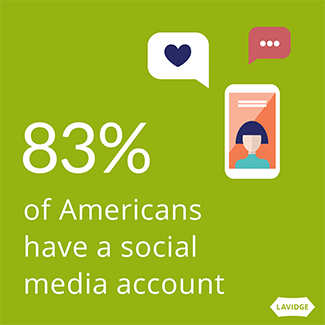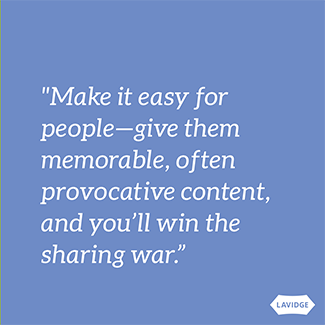Sign up for our LAVY email
and get our bi-monthly newsletter.
You spend significant resources creating a well-crafted piece of content for your healthcare website, blog or social platforms, but no one seems to be sharing it. That’s what you want, right? You dream of social content that gets shared, goes viral and results in measurable customer lift.
But it doesn’t happen. Your social media posts appear to wallow in loneliness.
It’s smart to want your social media content to be shared because it amplifies the messages in your overall marketing strategy. Ideally, that will result in increased brand awareness, word of mouth and referrals. Social sharing lends you credibility and can also enhance your visibility on search engines (SEO). Better yet, after the initial investment to create and post your social content, the exposure via social media sites doesn’t cost anything.
It’s no wonder brand marketers want their content to make the rounds.

Before taking other measures, check to ensure you’re set up for success. There might be technical explanations why your content isn’t being shared, and you should investigate them first.
It’s important to make social sharing intuitive. As an example, it’s vital that your website blog provides easy access to social media icon sharing buttons. Floating social media icons in close proximity to your content will encourage people to quickly share it on Facebook, LinkedIn or by email. Be sure to test these functions on a regular basis as part of maintaining your overall healthcare marketing strategy.
If you’re confident you’re set up for technical success and your healthcare content still isn’t being shared, then it might be time for a reality check. After all, unless you’re the Mayo Clinic or WebMD, there’s a pretty good chance your content won’t be easily found online. You’re not likely to win that battle. And if your brand can’t be found, sharing won’t happen.
Hospitals, physicians and other healthcare institutions have another hurdle to overcome—many of their most interesting potential content marketing topics can be seen as embarrassing. Some things are too private to get publicly shared. For example, content about birth control or herpes might be viewed as sensitive and, therefore, won’t be publicly shared on social channels. If that’s the case, don’t look to shares or user-generated content from your target audience as your measure of success. Instead, consider page visits as the litmus for achievement.
If you truly want to get attention, you should consider the advantages of pushing the envelope and being provocative.
There’s a reason why Michael Salzhauer, M.D., is winning the social media war. Dr. Salzhauer, a board-certified Miami plastic surgeon, is better known as Dr. Miami, who rose to social media fame by broadcasting actual medical procedures on Snapchat (@therealdrmiami) that have hit 1 million views. From breast augmentations to tummy tuck surgeries, Salzhauer understands that “sexy” sells. He’s also created the iSurgeon app that will allow you to “perform” plastic surgery on your friends.
Has Dr. Salzhauer figured out how to conquer the healthcare brand social sharing problem? You bet. Has it brought him new patients? Unquestionably—he’s booked through, a year in advance.
The Dr. Miami example offers a great lesson about the rubbernecking principle; we’re drawn to strange and bizarre things and can’t look away, even though they might be abhorrent. That’s why traffic slows down near an accident. We seek out the unusual and can’t help but watch.
That same concept underscores the importance of creating headlines with hooks and images that attract attention on healthcare industry social media accounts. If an article appears to be boring, then it probably is. Appearance counts.
Healthcare organizations that are typically conservative can still get in on the action. How about establishing a “Dr. Rattlesnake Bite” persona, or a “Welcome to the World” blog that focuses on birthing topics in an interesting and educational manner?
Other reasons your content sharing isn’t up to snuff might include low frequency. There’s no definite answer to the “how much content is enough” question. A lengthy, high-quality article is certainly better than several short pieces that don’t offer value or aren’t SEO friendly. In any case, it’s probably a good idea to look at what your competitors are doing. If they are posting frequent quality content, then consider doing the same.
In general, it’s a good idea to add fresh content—to your blog, for example—once a week. Frequency provides an incentive for people to visit on a regular basis. And Google’s algorithms like it, too. Post likeable content on a regular basis, and promote it via all the social platforms that make sense.
 Final thought
Final thoughtIt’s important to remember that consumers are looking at healthcare providers as brands. More than ever, consumers are exercising choice. They are doing their own research, being much more proactive with their health . . . and are paying attention. They want great content, and they want to share it. Make it easy for people—give them memorable, often provocative content, and you’ll win the sharing war.
Not sure where to start? No problem. LAVIDGE experts in developing sharable social media content can point the way.
To learn more, give us a call at 480.998.2600 or send email to info@lavidge.com.
Review these questions if you're not satisfied with how frequently your content is shared.
Do you provide social media icon sharing buttons adjacent to all your content?
Do you frequently test the functionality of your social media icon sharing buttons to ensure there are no technical problems?
Do you provide in-text links to foster sharing?
If your content isn’t shared often, have you considered that page visits might be a better barometer of success?
Do your content headlines have hooks?
Are your images designed to attract attention?
Is your content provocative?
Do you post valuable content on a regular basis, and promote it via all your social platforms?
Sign up for our LAVY email
and get our bi-monthly newsletter.